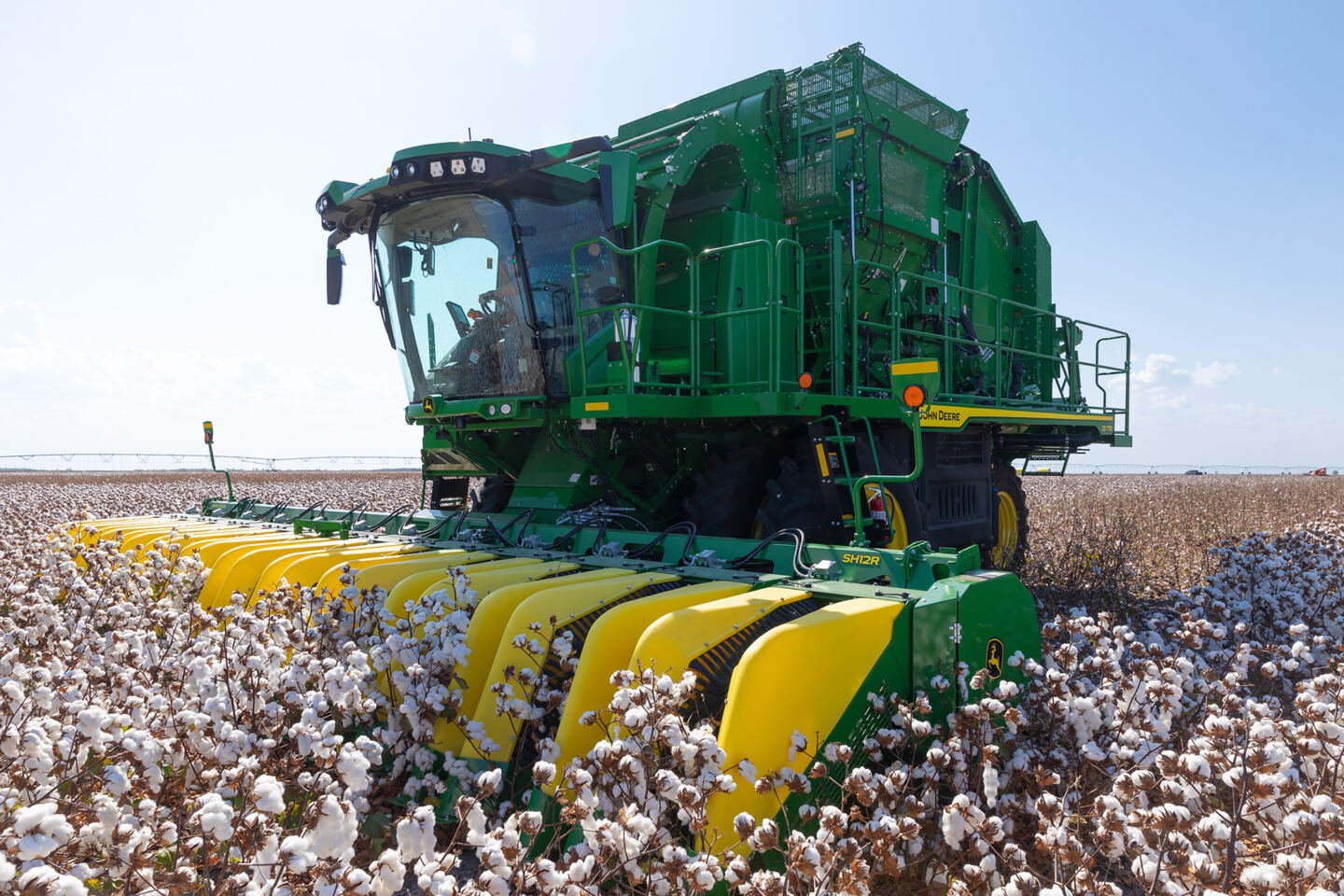
Enhancing Cotton Picker Performance: Upgrading Your Gathering Chains
The growing adoption of automated and robotic systems to ease production and harvesting is boosting the cotton picker market. However, mechanical problems with the machine can affect its performance.
Practicing proper picker cleaning and servicing helps reduce the risk of fire. For example, a smoldering picker fire that is not cleaned quickly can cause hydraulic oil and diesel fuel lines to rupture.
Gathering Chains
Whether you are harvesting down corn or a normal crop, properly setting your gathering chains makes all the difference. First, make sure that your chain’s lugs are opposed to each other (Case IH and John Deere corn heads come from the factory with them staggered). This adjustment improves the chain’s grabbing and conveying ability in down crop, moving dislodged material up the row-unit faster. Second, make sure the chain’s snout angle and spring pressure adjustments are tight. Adjustments that are out of spec can reduce your gather capacity by up to 20 percent.
These adjustments are easy to perform and will increase your harvest efficiency. To maximize a corn head’s performance in the down crop, you should also set the chain to run slower than the stalk roll tip speed. This synchronizes the gather chain lug speed with ground and stalk behavior to reduce trash intake and increase the ability of your harvester to pick the crop.
Drago’s massive gathering chains ride on oversized idler sprockets that reduce chain wear and are forward placed, allowing overlapping chain fingers to grab and capture the stalk for processing. This feature is particularly valuable when picking downed corn and helps to prevent excessive trash from entering the combine.
The gathering chains feature five poly chain guides that extend chain life, and they are reversible so one side is not worn out before the other. They are connected by a captured nut tensioner that requires no servicing. The tensioner has two bearings stacked together that form a grease reservoir, making it possible to check the grease level with a simple dipstick in the center of the tensioner.
The chain itself is made of austempered ductile iron to resist bending and impact damage. It has a unique octagon pattern that distributes load and pin forces over a larger area, increasing its life. These gathering chains are lubed for life, making maintenance an easy task. The lubrication system uses a special, high-flow grease that wicks into the grooves and crevices of the link plates to keep the chain properly lubricated. The chain is easily removed and replaced using a Geringhoff special tool that comes with every head.
Spindles
The cotton picker’s spindle system is vital for a successful harvest. The system’s patented design allows for more thorough plant penetration and complete coverage of the cotton row on both sides of the machine with minimal loss. This enables the picking drum to pick higher basket loads and increase your yield, even in a poor crop.
To ensure your spindles are delivering maximum performance, inspect the doffers and moisture system columns for proper operation. Using a feeler gauge (or a crisp dollar bill), measure the distance between the doffer lugs and the top of the spindle. Doffer-to-spindle clearances should operate within 0.003 inch to 0.008 inch. If doffers are operating outside this range, lowering them may accelerate the wear of doffers, bushings, and spindles without improving doffing significantly.
During the inspection, be sure to look for signs of excessive lug wear. Loose or missing lugs reduce your chain’s load-bearing capacity and cause the link to fatigue. If the lugs are loose or missing, they need to be tightened or replaced. Similarly, the lug height must be checked and adjusted to ensure they properly contact the chain strands.
Spindle maintenance is also important for your cotton picker’s performance. Geringhoff recommends lubricating your spindles with a high-quality dry film lubricant. This type of lubricant helps prevent dry sliding conditions, which can lead to premature spindle wear.
In addition to regular lubrication, your spindles will benefit from periodic cleaning with a special cotton picker spindle cleaner. This cleaner will remove buildup from the spindle’s trough and improve its surface finish for improved friction.
Before using a cotton picker spindle cleaner, make sure that your equipment is free of debris and foreign matter. The last thing you want is to introduce a foreign material into the spinning wheel, which could result in a fire hazard and damage your harvesting equipment. In order to avoid this, clean your machinery regularly and keep it free of foreign materials. If you are unsure of how to do this, consult your manufacturer or local dealer for more information.

Moistener Pads
Moistening pads on a cotton picker are critical to harvesting high-quality, boll-free cotton. Regularly check pads and clean out any accumulated debris before picking to keep pads from clogging. Also, routinely inspect pads and replace worn-out pad rubbers to ensure they will work properly.
Keeping your cotton picker in tip-top condition is the best way to maximize productivity and reduce downtime during the harvesting season. It is also important to have a proper fuel tank size and a large enough battery to power your machine throughout the day of work. It is also important to inspect the oil flow, electronic settings on your engine, and lubrication of all components.
The fire monitoring system of the cotton picker consists of a CO concentration sensor and a temperature and humidity sensor, which are used to monitor the change in gas concentration, temperature, and humidity in the cotton box to prevent smoldering and fire. The sensors are connected to an industrial control host computer system, which monitors the data in real-time and displays it on the vehicle terminal. The GA-BP neural network algorithm then processes the sensor data to obtain an optimized model and predict the fire situation of the cotton picker.
When the smoldering of cotton occurs, the fire warning signal will be displayed on the vehicle terminal, and the alarm system will be activated. Then the driver will be alerted of the danger, and the fire can be extinguished in time to avoid a big loss.
Row units on a cotton picker should be tilted somewhat to cause the lowest spindles in the bars to enter the plants at the lowest possible height, maintaining the bottom of the row-unit about 1 inch above the soil. This arrangement leaves very little gap between the front and back spindles moving through each plant from entry to exit of the picking zone and provides greater harvesting efficiency. Row unit tilt also positions the rear of the cabinets at a slightly different height than the front, which helps to shed trash easier and reduces accumulation and dragging of shedded plant material.
Belts
The cotton picker is a piece of machinery that requires a lot of maintenance. It is also expensive to repair and maintain. You can upgrade your equipment with simple improvements to reduce costs and downtime. For example, you can replace the belts in your engine, row unit, and cab to improve performance.
The new cab is designed to provide better visibility and ergonomics for the operator. In addition, it is equipped with the CommandCenter touchscreen display and digital corner post displays to help the operator monitor system functions. Additionally, the hydraulic locking switch on the control console locks all of the row units and basket controls while the picker is in road condition.
This year’s crop is expected to be larger and tougher than ever, putting more demand on your equipment. That’s why you need the best-in-class harvesting technology to maximize your productivity and keep your machine up and running all season long.
Fortunately, you can make several simple upgrades to your John Deere cotton picker to ensure maximum efficiency and uptime this season.
First, make sure you’re synchronizing your gathering chains to ground speed. This will help you capture down corn and move dislodged stalks up into the row unit faster. Another adjustment is to set the gathering chain lugs so they are opposed to each other. This makes them more aggressive in moving dislodged stalks up the row unit and enhances grabbing and conveying ability in down corn.
To reduce maintenance time and costs further, consider switching to 360 YIELD SAVER gathering chains. This new design features large, rugged gather lugs and a chain link profile that reduces trash intake and shelling loss. It also uses replaceable brush blocks that snap and screw into place to quickly and easily remove stray kernels, nuts, and nubbins from harvesting. In addition to being easy to install, they are highly durable and have an average life expectancy of more than 150 acres per harvest. They are also the only gathering chains on the market that can be serviced with a standard hammer.




